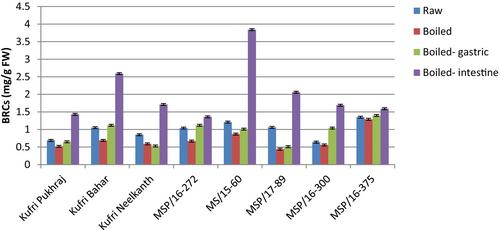Diabetes type II is growing rapidly as a result of the global shift in dietary and lifestyle habits. Although there are many pharmacological treatments for diabetes, incorporating foods with antidiabetic components into daily diet will be helpful. The present study compared the difference in the bioaccessibility of biguanide-related compounds (BRCs, antidiabetic compounds) and phenolics from yellow, red, and purple potatoes.
Color-based averaged results showed that only biofortified red-fleshed advanced potato clones showed higher bioaccessibility (14%) of BRCs compared to light yellow potatoes. Among all the tested compounds, only BRCs were released to maximum extent in the intestinal phase from all varieties and advance clones. This is the first report that revealed potatoes to be a good source of BRCs due to their high bioaccessibility. Bioaccessibility of phenolic compounds from boiled potatoes was 1.1-fold higher in red colored, whereas almost 2-fold higher in purple potatoes. Compared to light yellow potatoes, bioaccesibility of 3-caffeoylquinic acid, 5-O-caffeoylquinic acid and 4-O-caffeoylquinic acid was 5.1, 5.7, 4.6 fold higher in boiled red potatoes, respectively, and 4.6, 3.7, and 6.9 fold higher in boiled purple potatoes, respectively. Total anthocyanins showed color-dependent bioaccessibility and were 3.2 and 16.2 fold more bioaccessible from red and purple boiled potatoes, respectively, compared to light yellow potatoes.
Due to high bioaccessibility of phenolics, anthocyanins, and BRCs, purple and red potatoes can play pivotal role in health improvement of consumers worldwide. However, further detailed bioavailability studies are required to confirm these results.


